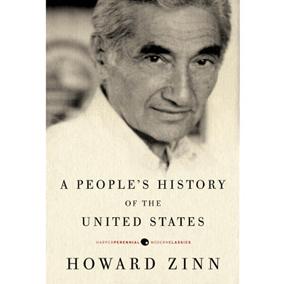
Does Zinn's alternative history teach bad lessons?
Howard Zinn's A People's History of the United States — a radical alternative to established textbooks when it was first published in 1980 — has today become a standard source in how Americans learn about their nation's history. Now an analysis by Stanford University School of Education Professor Sam Wineburg shows how it perpetrates the same errors of historical practice as the tomes it aimed to correct.
It would be difficult to overstate the degree to whichA People's History has resonated with the American public. Although its perspective is unabashedly from the far left, its reach and influence extend far beyond that quarter with more than 2 million copies in print and prominent displays in suburban superstores.
Zinn was a featured speaker in 2008 at the National Council for the Social Studies — the nation's largest gathering of social studies teachers. When he died two years later, his book rose to seventh on Amazon's best-sellers list.
"In the 32 years since its original publication, A People's History has gone from a book that buzzed about the ear of the dominant narrative to its current status where, in many circles, it has become the dominant narrative," Wineburg writes in an article in the latest edition of American Educator. "For many students, A People's History will be the first full-length history book they read, and for some, it will be the only one."
Wineburg, one of the world's top researchers in the field of history education, raises larger issues about how history should be taught. He says that Zinn's desire to cast a light on what he saw as historic injustice was a crusade built on secondary sources of questionable provenance, omission of exculpatory evidence, leading questions and shaky connections between evidence and conclusions.
Wineburg's critique focuses on the part of Zinn's narrative that covers the mid-thirties to the Cold War. Among the subjects it delves into is Zinn's assertion that African Americans were largely indifferent to the outcome of World War II. That claim, Wineburg explains, is based on three anecdotal bits — a quote from a black journalist, a quote from a black student and a poem published in the black press — and excludes any evidence to the contrary.
Indeed, says Wineburg, while Zinn pulled his anecdotes from a secondary source, Lawrence Wittner's 1969 book Rebels Against War, Zinn also ignored evidence in that same book that undermines his claim. Among the examples Zinn overlooks is Wittner's point that 24 percent of the registrants eligible for the war were African American, while the percentage of draft-evasion cases involving blacks was only 4.4 percent of the total pursued by the Justice Department. And a similar trend held with conscientious objectors. "Surprisingly few black men became C.O.s," Wittner adds.
Similarly, Zinn roots his argument that the Japanese were prepared to surrender before the United States dropped the atomic bomb on a diplomatic cable from the Japanese to the Russians, supposedly signaling a willingness to capitulate. Wineburg writes that Zinn not only excludes the responses to the cable, but also that he fails in the later editions of the book to incorporate the vast new scholarship that emerged after the death of the Emperor Hirohito with the publication of memoirs and new availability of public records, all of which support the position of Japan's resolve to fight to the last.
Wineburg acknowledges that Zinn's book was an important contribution when first published. While the standard textbooks of that time presented a certainty about one view of the nation's history, from Manifest Destiny to the United States' moral superiority in the Cold War, Zinn put forward largely overlooked alternative perspectives, such as how slaves viewed the Constitution and how the Cherokees felt about President Andrew Jackson. Zinn weaved a seamless unified theory of oppression in which the rich and powerful afflict the poor and disenfranchised.
Over time, however, a problem emerged as Zinn's book became the single authoritative source of history for so many Americans, Wineburg said. In substituting one buttoned-up interpretation of the past for another, Wineburg finds, A People's History and traditional textbooks are mirror images that relegate students to similar roles as absorbers – not analysts – of information. Wineburg writes that a heavily filtered and weighted interpretation becomes dangerous when "we are talking about how we educate the young, those who do not yet get the interpretive game."
History, Wineburg notes, is messy. And the most responsible thing for educators to do is to leave elbowroom for the mess. "History as truth, issued from the left or the right, abhors shades of gray," Wineburg writes, adding, "Such a history atrophies our tolerance for complexity. It makes us allergic to exceptions to the rule. Worst of all it depletes the moral courage we need to revise our beliefs in the face of new evidence.
"It insures ultimately that tomorrow we will think exactly as we thought yesterday — and the day before and the day before that."
David Plotnikoff writes frequently for the Stanford University School of Education.



